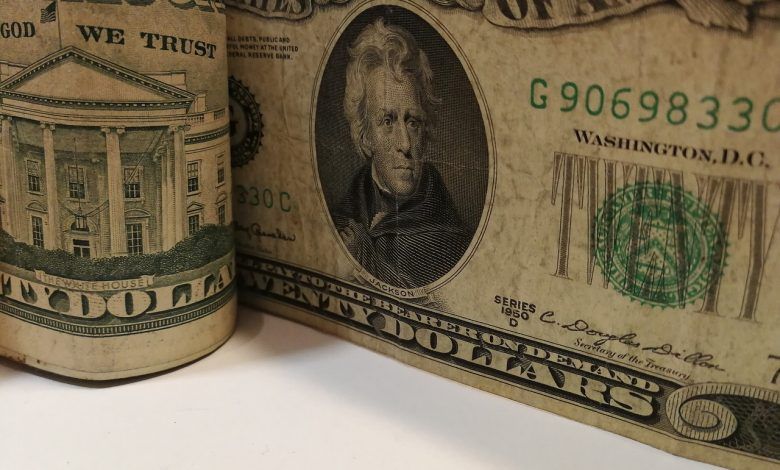The peso appreciates 47 cents against the dollar

The peso closed April with a depreciation of 1.99% or 47.2 cents, trading around 24.14 pesos per dollar, accumulating three months down.
In this three-month period, the peso has depreciated 28.1% or 5 pesos and 30 cents.
During April, the exchange rate reached a minimum of 23.2460 pesos and a new historical maximum of 25.7849 pesos per dollar, although the upward trend observed during March was successfully stopped.
Despite the fact that the exchange rate traded most of the time in a channel between 23.50 and 25.50 pesos per dollar, the volatility of the month remained high at 24.8%, as a result of a higher perception of risk with respect to Mexico and a clear capital outflow during the first half of the month.
The peso and context
The main determinants of the exchange rate movements in the month were:
First factor
The first indicators were published that showed the economic impact of the coronavirus pandemic globally, observing a significant jump in unemployment in the United States, drops in consumption in the most affected economies, and contractions in the service sector and industrial activity.
At the end of the month, severe contractions in the GDP of several western economies were published. In Mexico, GDP contracted at a quarterly rate of 1.55% and an annual rate of 2.37 percent.
It should be added that this is the second time that Mexico’s GDP has decreased five consecutive quarters. The first time was from the fourth quarter of 1985 to the fourth quarter of 1986, when the Mexican economy showed signs of deterioration and the 1985 earthquake was the last trigger for the recession.
Similarly in 2019, Mexico showed a severe economic stagnation that was not classified as a recession due to lack of depth in the falls in GDP. Now with the health crisis, one can not only speak of a recession, but also an economic crisis due to the expectation of a deep fall in Mexico’s GDP.
Second factor
The severe global economic recession, known as “The Great Encierro”, has had a particularly negative effect on the currencies of emerging economies and countries that produce raw materials, as their demand for the production of final goods has decreased.
In the month, the price of WTI oil reached negative levels for the first time in history, momentarily hitting a low of -40.32 dollars per barrel, due to the risk that the storage capacity of crude oil will be depleted in the United States.
Towards the end of the month, the price of oil recovered to close to $ 20 per barrel, since during April oil production fell from 13 to 12.1 million barrels per day and this trend is expected to continue. Going forward, further declines in oil prices cannot be ruled out.
Third factor
The Mexican peso is a currency particularly vulnerable to speculation, as it is the most liquid Latin American currency and operates 24 hours.
During the month, the Mexican peso lost ground as a result of the fall of the Brazilian real, which traded at a new all-time high of 5.2053 reais per dollar, as a result of an internal political crisis.
The peso is also vulnerable due to the deterioration of the credit profile of public debt and Pemex. During April, the rating agency Moody’s placed Pemex’s credit rating at speculative grade, with which two of the three main rating agencies place their debt at this level.
Going forward, the risk persists that a deterioration in the credit profile of sovereign debt, as Mexico’s economic recovery is likely to be slow, due to the absence of an expansive fiscal policy that supports companies and employment.
Fourth factor
At the end of the month, Pemex presented a net loss of 562.2 billion pesos in the first quarter of 2019, although this was mainly due to an exchange loss of 469.2 billion pesos due to the depreciation of the peso against the dollar.
Total sales totaled 284.1 billion pesos, 20.24% below what was reported in the first quarter of 2019. Costs of sales decreased by only 5.30%, to 243 billion pesos, so the sales margin fell drastically from 38.82% to 16.91%. This is a sign that the global economic context affects Pemex’s income significantly more than its expenses.
During the first quarter, the average price of the Mexican mix was $ 41.02 per barrel in the quarter, $ 14.6 below the previous year’s average.
However, these prices do not capture the falls seen in April, which even caused the price to temporarily fall into negative territory.
The peso and other currencies
It is important to add that, in other markets, particularly in the capital markets, strong gains were observed during April, as the rate of infections in Europe and the United States decreased, generating the expectation that these countries will begin to relax the measures that restricted the operation. non-essential business and people.
Monetary and fiscal stimuli were also approved in advanced economies, including monetary expansions and cuts in interest rates to record lows.
Finally, there were days of optimism about moderate advances in the work of pharmacists to find a cure for Covid-19.
In the month, the exchange rate touched a minimum of 23.2460 pesos and a maximum of 25.7849 pesos. The euro-peso reached a minimum of 25.2575 and a maximum of 27.8864 pesos per euro in the interbank prices for sale. For its part, the euro touched a minimum of 1,077 and a maximum of $ 1,0991 per euro.
At the close, the interbank quotations for sale were 23.1420 pesos per dollar, 1.2593 dollars per pound and 1.0953 dollars per euro.
Gabriela Siller; PhD
Director of Economic-Financial Analysis.
Banco BASE

